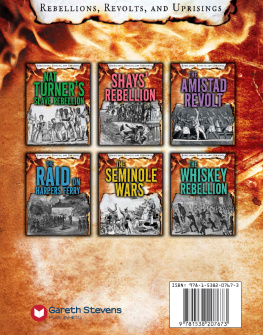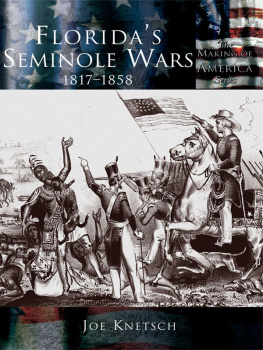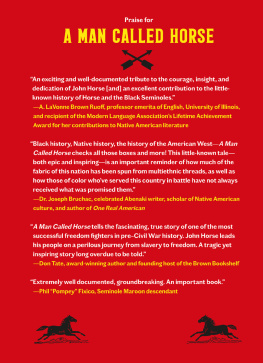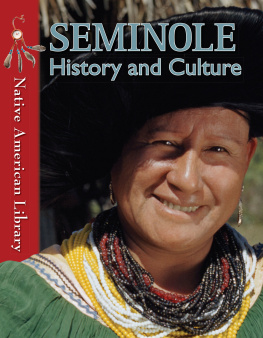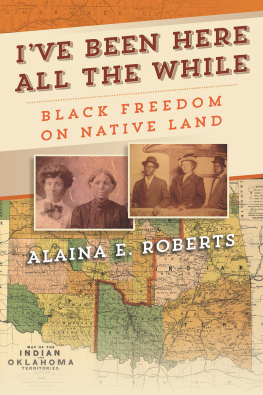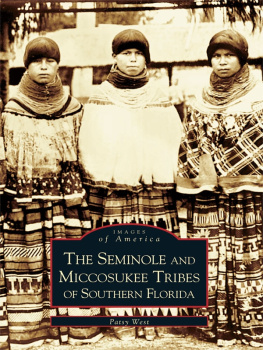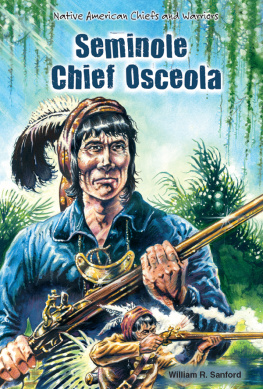Please visit our website, www.garethstevens.com. For a free color catalog of all our high-quality books, call toll-free 1-800-542-2595 or fax 1-877-542-2596.
CATALOGING-IN-PUBLICATION DATA
Names: Roxburgh, Ellis.
Title: The Seminole Wars / Ellis Roxburgh.
Description: New York : Gareth Stevens Publishing, 2018. | Series: Rebellions, revolts, and uprisings | Includes index.
Identifiers: ISBN 9781538207734 (pbk.) | ISBN 9781538207673 (library bound) | ISBN 9781538207550 (6 pack)
Subjects: LCSH: Seminole Indians--Wars. | Seminole War, 1st, 1817-1818. | Seminole War, 2nd, 1835-1842. | Seminole War, 3rd, 1855-1858.
Classification: LCC E83.817 R69 2018 | DDC 973.57--dc23
Published in 2018 by
Gareth Stevens Publishing
111 East 14th Street, Suite 349
New York, NY 10003
Copyright 2018 Gareth Stevens Publishing
For Brown Bear Books Ltd:
Managing Editor: Tim Cooke
Designer: Lynne Lennon
Editorial Director: Lindsey Lowe
Childrens Publisher: Anne ODaly
Design Manager: Keith Davis
Picture Manager: Sophie Mortimer
Picture Credits
Cover: Getty: MPI, Archive Photos
Interior: Alamy: Vanessa Grossemy .
All other images Brown Bear Books
Brown Bear Books has made every attempt to contact the copyright holder.
If anyone has any information please contact
All rights reserved. No part of this book may be reproduced in any form without permission in writing from the publisher, except by a reviewer.
Manufactured in the United States of America
CPSIA compliance information: Batch #CS17GS. For further information contact Gareth Stevens, New York, New York at 1-800-542-2595.
ROOTS OF REBELLION
Between 1817 and 1858, Native Americans fought three separate wars against the United States in Florida. These Seminole Wars were the longest of all Native American wars against the US government.
The Seminole Wars had two main causes. One was slavery, and the other was US expansion over the North American continent. The first European settlers in Florida were Spanish. Slavery was an established practice in southern Spain. Since the first conquistadors had sailed across the Atlantic Ocean, the Spaniards had brought slaves to the Americas.
Slavery under the Spaniards was different from slavery elsewhere in North America. Under Spanish law, slaves were allowed to own property and transfer it as they wanted. They also had legal rights, including the right to self-purchase. This gave a slave who had saved enough money the right to pay off his or her master. Many slaves used this right of self-purchase to buy their freedom. A class of free blacks existed first in Spain and then in Spanish America.
Slave traders split up an African family after the father is sold into slavery in the United States.
Settling Florida
The first Spaniard in Florida was Juan Ponce de Lon, who claimed the region for Spain in 1513. In 1565, Spain founded a fort in St. Augustine. It is now the oldest continually occupied European settlement in the United States.
Hernando de Soto brought African slaves to Florida in 1539.
SPAINS SANCTUARY POLICY
IN 1693, SPAIN WAS INCREASING ITS SETTLEMENT OF FLORIDA. TO ATTRACT MORE SETTLERS, IT INTRODUCED A POLICY THAT STATED THAT ANY SLAVE WHO MOVED TO FLORIDA AND CONVERTED TO CATHOLICISM WOULD BE GRANTED HIS OR HER FREEDOM. THE PROMISE ATTRACTED A FLOW OF BLACK IMMIGRANTS FROM THE NORTH. ENGLANDS COLONY IN CAROLINA OBJECTED TO THE POLICY, BECAUSE SO MANY OF ITS SLAVES FLED SOUTH. IN THE EARLY 1800S, THE NEWLY FORMED UNITED STATES ALSO BECAME INCREASINGLY WORRIED ABOUT THE POLICY.
Florida was part of Spains Caribbean territories for nearly 300 years before the United States took control in 1821 (Florida was briefly under British rule from 1763 to 1784). Under the Spanish, Florida developed differently from the English colonies to the north, which became US states in 1776. Slaves in Florida received better treatment than their neighbors in other states. By the early 1700s, many black slaves in Georgia and the Carolinas had escaped from their masters to Florida. There, the Spanish authorities allowed them to stay if they converted to the Catholic religion.
The Spaniards built Fort Matanzas to guard St. Augustine.
The Spanish let escaped slaves and freed African Americans organize their own social and economic activities. The former slaves had far more freedom than they had farther north. They even served in Spanish militias.
A Challenge
From 1763 until the end of the Revolutionary War in 1784, the British seized temporary control of Florida. The British government wanted British people to move there.
Large parts of central Florida were covered in semitropical swamps.
This was the treasury of Spanish Florida in St. Augustine.
The British gave settlers their own land. The new settlers needed slaves to work their land. The freedoms that had been enjoyed by Floridas slaves and freed blacks were over. Life became harsher. The British brought slaves from Sierra Leone in West Africa to work on plantations.
British rule was short-lived, however. At the end of the Revolutionary War, Florida was returned to Spanish control. The change led to chaos. Many slaves in Florida took the chance to escape from their British owners. They fled from the plantations and went to live with the Seminole people who lived on the central plains of northern Florida.
DID YOU KNOW?
THE BRITISH ORIGINALLY TOOK CONTROL OF FLORIDA FROM SPAIN IN 1763 AS PART OF A WIDER EUROPEAN CONFLICT KNOWN AS THE SEVEN YEARS WAR.
Various Native American peoples had moved to Florida in the early 1700s to avoid wars farther north. These refugees came from several different tribes, including the Creek. In Florida they mingled with local Native peoples, such as the Choctaw. A new band emerged, known as the Seminole.
Pressure from the New Government
Under Spanish rule from 1784 to 1821, the numbers of freed blacks and slaves in Florida grew. The British who remained in Florida usually owned a large number of slaves. A typical plantation owner might have between 50 and 200 slaves. Generations of the same slave family worked on a plantation.
Spanish troops defeat the British at Pensacola in 1784, taking back control of Florida.
THE WAR OF 1812
IN 1812, THE UNITED STATES WENT TO WAR WITH GREAT BRITAIN AND ITS ALLIES. ONE CAUSE WAS BRITAINS ATTEMPTS TO RECRUIT AMERICANS INTO ITS NAVY IN EUROPE. BRITAIN ALSO LENT ITS SUPPORT TO NATIVE AMERICANS FIGHTING AGAINST THE UNITED STATES, AND IMPOSED RESTRICTIONS ON US TRADE. THE 3-YEAR WAR ENDED IN A STALEMATE AFTER THE BATTLE OF NEW ORLEANS IN 1815.

